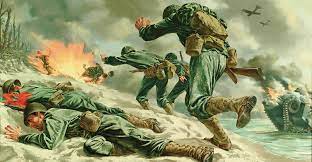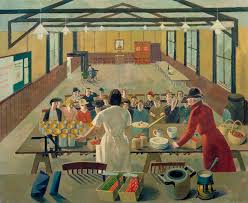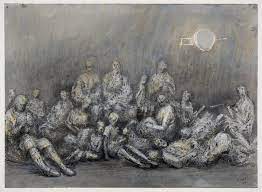The Impact of WWII on the Mid Modern Era
The Impact of WWII on the Mid Modern Era

Hitting the Beach by Tom Lee
Painted in 1944 Location: Depiction of Peleliu
Painted in 1944 Location: Depiction of Peleliu
Tom Lea was a war correspondent for Life Magazine. He originally went to school at the Art Institute of Chicago. In 1940 he took a job at Life Magazine and covered the war from 1941-1946. He would be put in places where he had a direct view of what the war looked like then he would paint what he saw. Some of his paintings are even hung in the Pentagon to be used as a reminder of how awful war is.
Elements
Two concepts that are greatly used in these paintings are color and contrast. Tom uses a lot of greens and darker colors to show how the bad the conditions were at that time. In The Price the red is the first thing that you see when you look at the painting. He also uses curves and lines to make the paintings look as if the people depicted are actually moving. In The Price you can tell that the person is injured and is struggling to walk and in Hitting the Beach you can see the soldiers throwing themselves to the ground.
Placement
The placement of the first painting makes the soldiers the most important part of the painting because the painting shows them front and center. The second painting the attention is solely on the soldier because their is nothing else around for the viewer to look at.
Emotions
These two painting both make the viewer have strong emotions. In the first painting you can see the soldiers hit the ground really fast and it makes you want to be able to do something to help them and get them to safety. The second painting is really sad because you can see that the soldier is really injured and that he is probably not going to make it. When you look at this painting it makes you sad that the soldiers life had to end in such a horrible way.
St Thomas Hospital in Evacuation Quarters
Created by: Evelyn Dunbar
Location: London in 1942
Created by: Evelyn Dunbar
Location: Unknown
Painted in 1940
Evelyn Dunbar was also a WWII artist but as you can see from her paintings she showed a different side of WWII. She showed the role that woman played during the war. She was the only female artist to get hired and paid by the government. She also spent weeks in a hospital observing what was happening and that is what the first painting is depicting.
Elements
She uses contrast in her paintings. In her paintings she uses a lot of reds and whites because they stand out against her yellow and green backgrounds. She also uses waves and curves to make it look as if the people depicted in the paintings are actually moving.
Placement
Even though their are a lot of people in these paintings she was able to position her paintings so that you can see everyone in the paintings. This along with using colors that stand out against the background help the nurses and other people in the paintings to stand out.
Emotions
These paintings have a lot of emotion for me because my mom is nurse and nursing has run in my family for many years. These paintings show how hard the nurses are working to make sure that they are doing their job properly. I also liked the canning painting because it shows them going out of their way to do anything they can to help with the war.
Grey Tube Shelter
Created by: Henry Moore
Located in: London 1940
A Tilbury Shelter Scene 1941
Created By: Henry Moore
Location: London
Henry Moore was a soldier in the Army during WWI. He then attended school to study art. The artwork that made him famous was one he did of the community in London sheltering from the Blitz. He was eventually asked to become a war artist.
Elements
Henry uses shadowing in both of these paintings. He uses shading to show how many people are crammed in this shelter while also showing how dark it was in the shelter. He also used curved lines to show each individual person laying on the ground so that we can see how many people were in the shelter.
Placement
The placement in these two paintings are important because he wanted us to be able to see as much of the people laying in the shelter as possible.
Emotion
The emotion that i get from these paintings is fear. Everyone is huddled together not knowing what is going to happen or if they are going to make it out safe. I also predict that their are children in the shelter with their mothers and they are most likely terrified.
References
“Biography.” Tom Lea Institute, 2020, www.tomlea.com/biography
Christopher. St Thomas’ Hospital in Evacuation Quarters (1942), 4 Sept. 2012, evelyn-dunbar.blogspot.com/2012/09/st-thomas-hospital-in-evacuation.html.
Hallett, Florence. “Henry Moore: The Artist in Wartime.” Henry Moore: The Artist in Wartime | The Tretyakov Gallery Magazine, 22 May 2020, www.tretyakovgallerymagazine.com/articles/1-2020-66/henry-moore-artist-wartime.







World War 1 art is always hard for me to look at, because it holds so much pain and emotion from the soldiers, and everyone involved during at the time. I kind of find it interesting that they hired artists to come to the battle areas or into war zones to make paintings of the scenes. However, it's such an important part of U.S. history, that having art that really captures the gruesome reality of war is vital in not only showing what people went through but to preventing it from happening again. I thought your blog was very well structured and I like how you sectioned your evaluations of the elements clear and orderly.
ReplyDeleteI think you did a really good job of structuring your blog and including all of the elements. I like how the reader could focus on each artist and style at one time before moving onto something else. It is interesting to me that the pentagon, the headquarters of defense in America, has some of Tom Lee's art displayed. It is ironic to me that the place that comes up with the plans and deals with war and safety in our nation has paintings to remind them of the awfulness war brings upon people. The artists all show so clearly what a tough time this was for everyone, the soldier paintings are much more dramatic and have some brighter colors, but most of these paintings are so grim, you can see everyones hardship and grief. I think it was pretty tough for the mothers and kids to be left and have to come up with ways to make money and run businesses and learn new things without heir husbands and fathers.
ReplyDeleteYour blog was very organized and interesting. Tom Lee's painting, "Hitting the Beach," stands out the most to me in your post because of the composition and the important information behind it. “Hitting the Beach” portrays a remarkable amount of movement, conveying a strong sense of danger and urgency as soldiers rush into battle on the beach. The positioning of their bodies gives them an almost animated look. The color composition, characterized by a variety of greens, effectively accentuates the blood in the image because of the contrast and the extreme visual difference between red and green. This image has immense power and significance, due to the artist's firsthand accounts and the lesson it teaches. Its depiction of the somber and horrifying aspects of war serves as a reminder to anyone who sees it, emphasizing the terrible effects and the cost of War.
ReplyDeleteGreat analysis of WWII art I really enjoyed reading your blog post about the impact of WWII on the mid modern era. You did a great analysis of the different artists and their styles, and how they reflected the realities and emotions of the war. I especially liked how you compared and contrasted the paintings of Tom Lea, Evelyn Dunbar, and Henry Moore, and how they used elements such as color, contrast, placement, and curves to convey their messages.
ReplyDelete